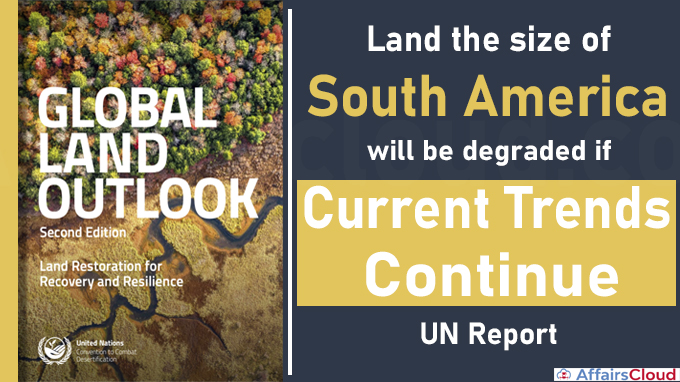
According to the United Nations (UN) Convention to Combat Desertification (UNCCD)’s evidence-based flagship publication, “Global Land Outlook Second Edition(GLO2): Land Restoration for Recovery and Resilience”, if the current trends continue, around 16 million square kilometers of land(the size of South America), which is 11% of the world’s land surface will be degraded by 2050.
- The degradation of land will result in severe climate induced disturbances which will result in disruption of food supply, forced migrations and increased species extinction.
The report was released ahead of the UNCCD’s 15th session of the Conference of Parties (COP15) to be held in Abidjan, Côte d’Ivoire from 9th to 20th May 2022.
About the report:
i.8 working papers were commissioned to provide insights and analysis on the major themes addressed in GLO2, subtitled Land Restoration for Recovery and Resilience.
ii.The report, five years in development with 21 partner organizations, and with over 1,000 references, is the most comprehensive consolidation of information on the topic ever assembled.
Note: The 1st edition of the Global Land Outlook(GLO1) was launched in September 2017 at COP13 in Ordos, China.
Gist of the report:
The report predicts the outcomes by 2050 and risks involved under three scenarios: Baseline; Restoration; and Restoration and Protection.
The scenarios provide an estimate of the potential of land restoration to mitigate and adapt to climate change as well as provide food, materials, and energy.
Baseline Scenario:
This is business as usual, where current trends in land and natural resource degradation are projected to continue through to 2050.
By 2050:
i.An additional 69 gigatonnes of carbon (soil organic carbon – 32 gigatonnes; vegetation – 27 gigatonnes; peatland degradation/conversion – 10 gigatonnes) is emitted from 2015 to 2050 due to land use change and soil degradation, this represents 17% of current annual greenhouse gas emission.
ii.Agricultural yields are expected to increase in all regions, land degradation will
curb increases, especially in the Middle East, North Africa, sub-Saharan Africa, and Latin America.
- The loss of soil organic carbon and the soil’s ability to hold water and nutrients, will be responsible for slowing in the growth of agricultural yields.
iii.The demand for food, expected to rise by 45% between 2015 and 2050, this has to be met through intensification and expansion of agricultural land, which will result in loss of an additional 3 million square kilometers of natural areas (the size of India), mainly in sub-Saharan Africa and Latin America.
Restoration Scenario:
This assumes the restoration of around 5 billion hectares (35% of the global land area) using measures such as agroforestry, grazing management, and assisted natural regeneration.
By 2050:
i.If land restoration is done on a massive scale across a potential five billion hectares with various measures, crop yields will increase by 5-10% in most developing countries compared to the baseline
ii.The carbon stocks will rise by a net 17 gigatonnes between 2015 and 2050 due to gains in soil carbon and reduced emissions.
iii.The biodiversity would continue to decline, with 11% of biodiversity loss averted.
Restoration and Protection Scenario:
In addition to the restoration measures, natural areas important for specific ecosystem functions are protected from land conversion.
By 2050:
i.The restoration of the land by 2050 will add an additional 4 million square kilometres of natural areas (size of India and Pakistan); largest gains expected in South and Southeast Asia and Latin America. Protections would prevent land degradation by logging, burning, draining, or conversion.
ii.Around a third of the biodiversity loss projected in the baseline would be prevented.
An additional 83 gigatonnes of carbon are stored compared to the baseline.
About United Nations Convention to Combat Desertification (UNCCD):
Executive Secretary- Ibrahim Thiaw
Headquarters– Bonn, Germany




